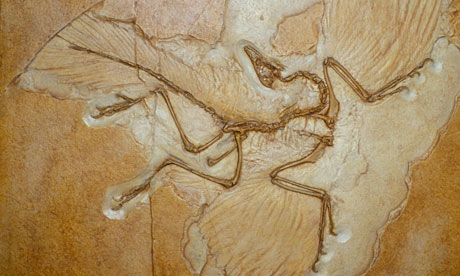The 10 greatest discoveries of zoology
A
panel of judges at BBC Wildlife Magazine has named the greatest
zoological discoveries of all time. Do you agree with their choices?

Archaeopteryx shares
some features with ancient reptiles and others with modern birds.
Photograph: Jason Edwards/Getty Images/National Geographic RF
Mid-way through the 4th century BC the Greek philosopher Aristotle turned his great mind to the wildlife around him and documented the behaviour and characteristics of hundreds of species in nine books that together became The History of Animals.
The work is impressive for its sheer scope and ambition. In 130,000 words, the author divides and categorises animal life every which way: by basic physiology and anatomy; by habitat and mode of movement; by how and what these creatures ate. Humans are not excluded from examination, but are woven throughout the text, giving Aristotle the opportunity to compare and contrast the essence of other species with that of our own.
There are some gems. He observes that elephants do not sleep standing up, but do copulate in lonely places. How fish hear is frankly a mystery since they don't seem to have ears. In humans, baldness is declared a consequence of sexual passion, since no boy, woman or castrated man ever loses hair like an intact adult man. So the inferences and assertions are often flawed (even if they contain a kernel of truth), but then how well will our own understanding of nature hold up in another 2,000 years?
The History of Animals might well be considered the starting point for zoology, at least in a systematic sense. By tackling questions like those Aristotle posed, scientists have made great strides in understanding the animal kingdom, from the collective behaviour of ant colonies and the intricate dances of honeybees, to the great migrations of whales and co-dependence of one species on another.
But what are the greatest zoological discoveries of all time? At BBC Wildlife magazine, a panel of judges has been mulling over the question. Today, the results of their deliberations are published as the top 10 breakthroughs in zoology. The list in full is below, in descending order. How have they fared?
The work is impressive for its sheer scope and ambition. In 130,000 words, the author divides and categorises animal life every which way: by basic physiology and anatomy; by habitat and mode of movement; by how and what these creatures ate. Humans are not excluded from examination, but are woven throughout the text, giving Aristotle the opportunity to compare and contrast the essence of other species with that of our own.
There are some gems. He observes that elephants do not sleep standing up, but do copulate in lonely places. How fish hear is frankly a mystery since they don't seem to have ears. In humans, baldness is declared a consequence of sexual passion, since no boy, woman or castrated man ever loses hair like an intact adult man. So the inferences and assertions are often flawed (even if they contain a kernel of truth), but then how well will our own understanding of nature hold up in another 2,000 years?
The History of Animals might well be considered the starting point for zoology, at least in a systematic sense. By tackling questions like those Aristotle posed, scientists have made great strides in understanding the animal kingdom, from the collective behaviour of ant colonies and the intricate dances of honeybees, to the great migrations of whales and co-dependence of one species on another.
But what are the greatest zoological discoveries of all time? At BBC Wildlife magazine, a panel of judges has been mulling over the question. Today, the results of their deliberations are published as the top 10 breakthroughs in zoology. The list in full is below, in descending order. How have they fared?
0 comments:
Post a Comment